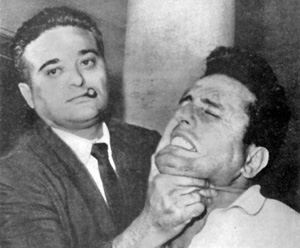Perp walk
Perp walk is a colloquial term used in the United States to describe the practice of law enforcement officials publicly parading an arrested suspect, often in handcuffs, before the media. The term "perp" is short for "perpetrator." The perp walk is typically orchestrated to allow the media to capture photographs and video footage of the suspect, which are then broadcast to the public.
History[edit | edit source]
The perp walk has its origins in the early 20th century, but it became more widely recognized in the latter half of the century. It is often associated with high-profile cases involving celebrities, politicians, and other public figures. The practice has been both criticized and defended by various parties.
Purpose[edit | edit source]
The primary purpose of a perp walk is to publicly demonstrate that law enforcement is taking action against crime. It serves as a form of public shaming and can be a powerful tool in the court of public opinion. However, it also raises significant ethical and legal concerns, particularly regarding the presumption of innocence and the potential for prejudicing a jury.
Legal and Ethical Issues[edit | edit source]
The perp walk raises several legal and ethical issues:
- Presumption of Innocence: Critics argue that perp walks undermine the presumption of innocence, as the public display of a suspect in handcuffs can create a perception of guilt.
- Right to Privacy: There are concerns about the invasion of privacy for the suspect, who may later be found innocent.
- Media Influence: The extensive media coverage of perp walks can influence public opinion and potentially prejudice a jury, making it difficult to ensure a fair trial.
Notable Cases[edit | edit source]
Several high-profile cases have involved perp walks, drawing significant media attention and public scrutiny. Some of these cases include:
- Bernie Madoff: The financier was famously perp-walked after his arrest for running a massive Ponzi scheme.
- Dominique Strauss-Kahn: The former head of the International Monetary Fund was perp-walked following his arrest on charges of sexual assault.
Criticism and Defense[edit | edit source]
Critics of the perp walk argue that it is a form of public humiliation that can damage the reputation of individuals who have not been convicted of a crime. They also point out that it can be used as a tool for law enforcement to gain favorable media coverage.
Defenders of the practice argue that it serves as a deterrent to crime and provides transparency in the criminal justice system. They also claim that it can be an important tool for law enforcement to demonstrate accountability and action.
Alternatives[edit | edit source]
Some jurisdictions have sought alternatives to the perp walk, such as:
- Conducting arrests in a more private manner to avoid media spectacle.
- Implementing policies that limit media access to suspects during the arrest process.
See Also[edit | edit source]
References[edit | edit source]
External Links[edit | edit source]
Navigation: Wellness - Encyclopedia - Health topics - Disease Index - Drugs - World Directory - Gray's Anatomy - Keto diet - Recipes
Search WikiMD
Ad.Tired of being Overweight? Try W8MD's physician weight loss program.
Semaglutide (Ozempic / Wegovy and Tirzepatide (Mounjaro / Zepbound) available.
Advertise on WikiMD
WikiMD is not a substitute for professional medical advice. See full disclaimer.
Credits:Most images are courtesy of Wikimedia commons, and templates Wikipedia, licensed under CC BY SA or similar.Contributors: Prab R. Tumpati, MD





